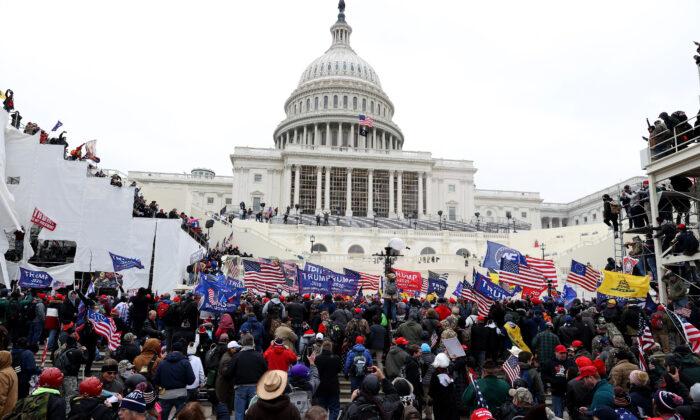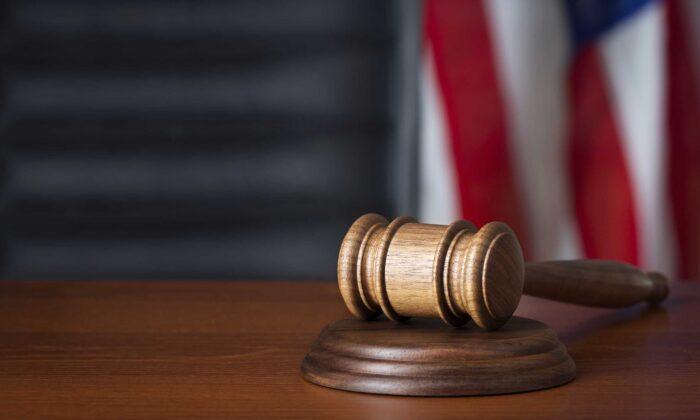It almost seems like the narrative was created in advance.
As the nation’s capital descended into chaos on the afternoon of Jan. 6—including angry protests both inside and outside the Capitol building objecting to Congress’s final certification of the 2020 election results—Democratic lawmakers were already spinning.
Lawmakers from both political parties echoed those sentiments throughout the day. Less than 24 hours later, House Speaker Nancy Pelosi (D-Calif.) cemented the emerging storyline about the events of Jan. 6.
Only two protestors, however, were found to be in possession of a firearm—and neither was inside the building on Jan. 6. They were detained later that night and charged with violating Washington, D.C.’s strict gun control laws.
So, four months later, is there any proof to back up the pervasive claim that Jan. 6 was an “armed insurrection?” After all, investigators now have a massive trove of video and social media posts to document what happened during the day in question; by now, clips of Trump insurrectionists carrying guns or braggadocious comments on Facebook should prove beyond a doubt that an “armed insurrection” indeed nearly toppled the U.S. government that day.
- Nine people with pepper spray;
- Nine people with a pole or flagpole;
- Four people with a riot or police shield;
- Four people with a small baton;
- Three people with a stick;
- Three people with a baseball bat;
- Two people with a taser;
- Two people with a fire extinguisher;
- Two people with a crutch;
- One person with a stun gun/walking stick;
- One person with a police helmet;
- One person with a knife;
- One person with a hockey stick;
- One person with an ice ax.
But in many cases, the defendant simply is charged with carrying the weapon, not using it against anyone—some protesters testified they brought weapons for self-defense in anticipation of violent engagement with agitators of Antifa or Black Lives Matter. Richard Barnett, the man famously photographed inside Pelosi’s office, faces two counts of possession of a “dangerous or deadly weapon,” to wit, a walking stick that can be used as a stun gun. In a court hearing last week, Barnett’s lawyer argued the item didn’t have batteries and wasn’t operational; a federal judge finally released Barnett from a D.C. jail after he had served nearly four months awaiting his trial.
Prosecutors are trying hard to salvage another myth about Jan. 6—that Officer Brian Sicknick was killed in the line of duty by Trump supporters. The New York Times eventually retracted its original story claiming Sicknick was murdered by “insurrectionists” using a fire extinguisher, but the media wasted no time pivoting to a new spin: Sicknick, the public was told, died as a result of a reaction to bear repellent sprayed on him by Trump supporters during the chaos.
But that isn’t true, either. The D.C. Medical Examiner’s office last month finally admitted Sicknick, 42, died of natural causes; nonetheless, Joe Biden’s Justice Department is desperate to keep the storyline alive. In March, two men were charged with using a chemical spray against the deceased officer. Prosecutors also had to admit in court last week that the spray was not bear spray, but a small can of pepper spray.
George Tanios and Julian Khater now sit in jail while denied bond, each facing three counts of using and possessing a deadly weapon, even though there is no proof the spray used by Khater hit Sicknick or his colleagues—just more prosecutorial blocking to support Pelosi’s stagecraft.
Much of Jan. 6 is a manufactured illusion, another exercise in political spin-making for partisan gain. But no amount of performative wishful thinking by the media, Democrats, and several Republicans about the existence of an “armed insurrection” on Jan. 6 can turn their imagination into reality.





